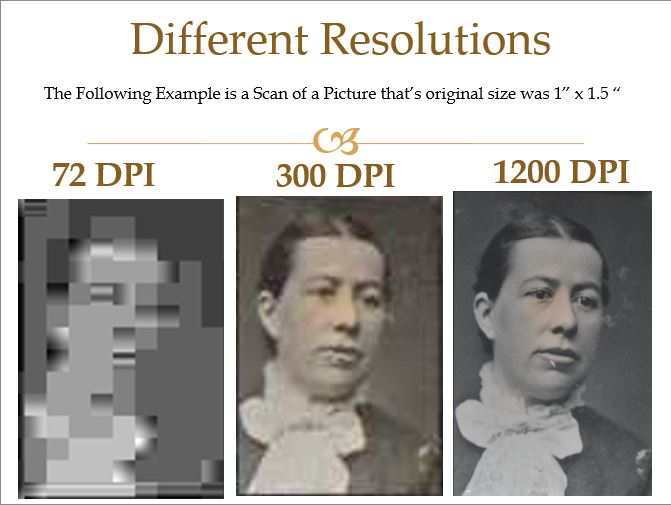-
Protected: Organizing Your Photos & Storing Them Safely
-
My Scanned Photos are Fuzzy ~ Help!
One of the questions I get asked a lot when I teach a class on photo scanning is, “Why are the photos I scanned so pixelated or fuzzy?” My answer is always, “You’ve scanned your pictures or photos in too low a resolution.”
What the heck is a resolution? Resolution is the quality of the scan and is measured in DPI, Pixels or Mega Pixels
What do all of these strange words mean? What is DPI? (Sounds like something dippy!) We are going to get just a bit technical here and talk about Dots Per Inch (DPI) or PPI (Pixels Per Inch).
DPI or Dots per Inch
- Refers to the printer and print quality and how many dots per inch the scanner will scan or the printer will print.
- The higher DPI the better the quality of the picture, in other words, the closer the dots the better the image.
- Most Scanners Scan in DPI rather than PPI
- This makes it easier to choose the correct printer and the dpi you would like it print.
- The higher the DPI the slower the scan and the more disk space the picture takes
- The larger the picture you want the higher the DPI needs to be.
PPI – Pixels Per Inch
- A pixel is a tiny square on a computerized display that is so small it appears as a dot
- PPI refers to how many actual Pixels are present per inch.
- If you scan at 600 PPI you will have 600 pixels per inch.
- The Resolution or PPI at which you scan determines the quality of the picture.
- The more pixels or dots that make up the display screen, the clearer the resolution or image will be. Greater numbers of dots or pixels allow for more refinement of the image, which results in higher, truer image replication.
A Megapixel or MP
- Refers to one million pixels, and is commonly used in reference to digital cameras as an indication of resolution capability.
- A printer capable of only 300 DPI (Dots per inch) will not print the 3.1-megapixel image in its native high quality. It’s simply not capable of reproducing the fine detail. Instead, the image may appear grainy.
- If you wish to print photos, be sure the printer is well suited to the capabilities of your digital camera.
Each Square Represents a Pixel

Q: So how can I set my DPI or PPI on my scanner and what should I set it at?
A: The lower the DPI or PPI setting, the fuzzier your picture will be.
A good rule of thumb for scanning pictures at the proper DPI for 300 dpi print copy is as follows: Scan large – you can reduce, but you can’t enlarge without losing quality. For print photos, always set the print DPI at 300.
.
Scanning Sizes:
To print half size of the photo or 50% size ~ Scan at 150 dpi, for 150/300 = 1/2X size
To print original size of the photo or 100% size ~ Scan at 300 dpi, for 300/300 = 1X size
To print double size of the photo or 200% size ~ Scan at 600 dpi, for 600/300 = 2X size
To print a small 35 mm film (about .92 inches X 1.41 inches) scan at 2700 dpi for 2700/300 or 9X size. This will give you a printable 8×12 inch copy
The formula for scanning is: DPI/300 = ratio of the size of the original photoBuying a Scanner
When purchasing a scanner for photo scanning there are some things to consider:
- Does it have a high PPI or DPI scanning capability
- Will it scan what I want, i.e. photos, negatives, slides
- Will it run on my computer’s operating system
- Does it have software that comes with it for not only photo scanning but for text scanning? (Text scanning includes OCR (Optical Character Recognition Scanning- another blog topic)
All of these items should be on the box or get a clerk to help you.
Scanning your photos should be a one time project, not a chore where you have to redo and undo. Get the settings right the first time and you can adjust your photos from there.
Photos posted online or emailed will need a lower resolution. Scan your photo in at the best DPI for an 8 X 10 or larger print photo. You can always make a copy of the photo file and reduce the size. Unfortunately, you cannot increase the size of a photo and have good results.
Scanning hardware and software for searchable pdfs and documents will be different and are not covered in this article.
Scanning Apps
There are free scanning apps for use with both Android and ios systems. One of the best scanning apps that I have found is google photos scan. It removes glare and the distortion you sometimes get when you just take a picture. It is also a lot faster than a regular flatbed scanner. The downside is the size of the photo and sometimes it comes with a stamp. Photomyne and UnfadePhoto are great apps as well although they cost money to use.
